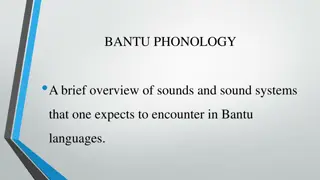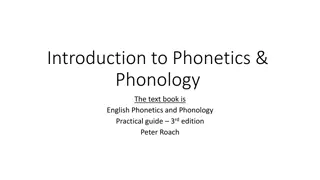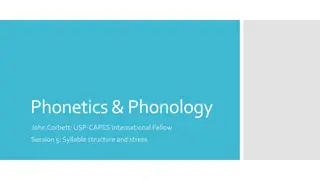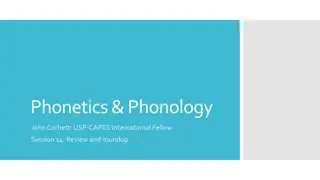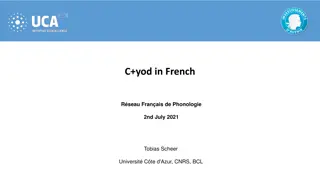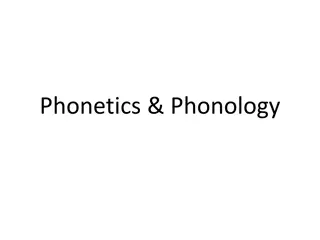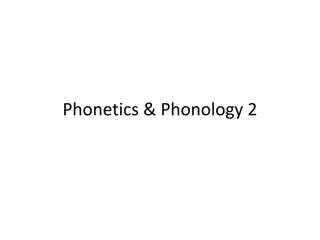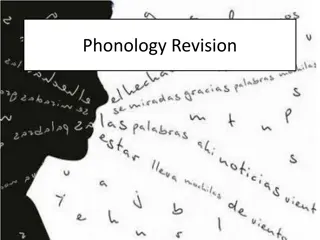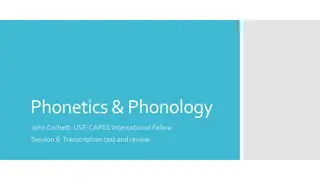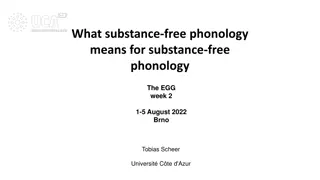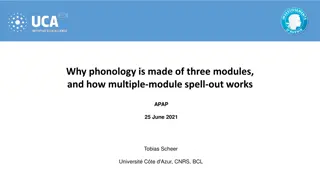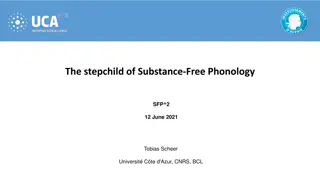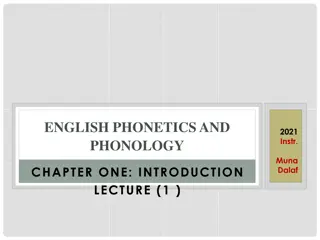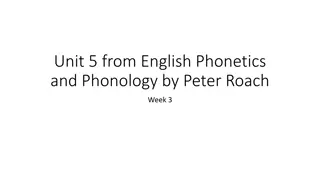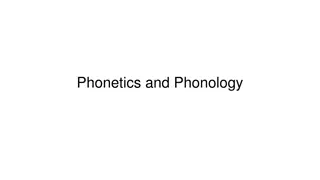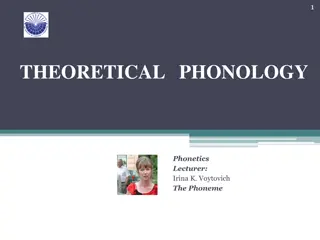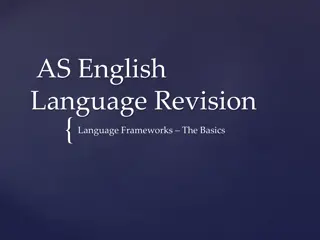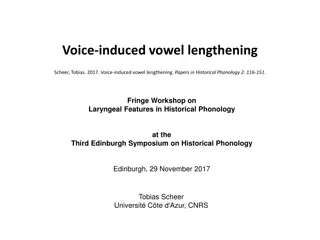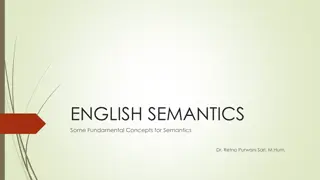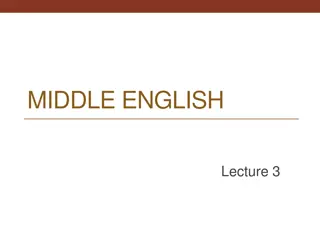Mastering English: A Comprehensive Approach to Teaching Language Skills
Education is not just preparation, but life itself. English language holds a vital place in our educational system and national life. This presentation explores the aims and objectives of teaching English, emphasizing the importance and impact of mastering the language at different education levels.
5 views • 32 slides
Insights into Theoretical English Grammar
The theoretical English grammar delves into the subject matter of grammar, including systemic conceptions, grammatical forms, categories, paradigms, and morphological means. It discusses the constituent parts of language – phonology, lexicology, and grammar. The grammatical structure covers morpho
7 views • 26 slides
The Etymology of Modern English Vocabulary: A Detailed Analysis
The etymology of modern English vocabulary explores words of native Anglo-Saxon origin, Germanic borrowings, and English elements, examining their characteristics and assimilation into the language. It delves into the ways borrowing occurs, criteria for assimilation, and the distinct layers comprisi
8 views • 15 slides
Evolution of English Literature: From Old English to Beowulf
The English language, evolving over 1,400 years, transitioned from Old English to Middle English with works like Beowulf standing as a pinnacle of Old English literature. The epic poem tells the tale of Beowulf's heroic feats in pagan Scandinavia, showcasing elements of alliteration, a key literary
0 views • 46 slides
Exploring Metrical Phonology: A Brief Overview
Metrical phonology, a subtheory of generative phonology, focuses on categorizing stress and stress rules within rhythmic hierarchies. It differs from generative phonology by not treating stress as a segmental feature specific to vowels. Originating from Halle's linear analysis, metrical stress theor
0 views • 32 slides
Exploring Bantu Phonology and Linguistic Classification
Delve into the intriguing world of Bantu phonology and linguistic classification, covering the diverse sounds and phonological processes found in Bantu languages. Discover the rich heritage of over 500 Bantu languages in sub-Saharan Africa, classified into zones and classes, shedding light on the fa
0 views • 38 slides
Exploring the Intersection of Arabic and English Language Learning
Delve into the fascinating world where Arabic and English intersect, with a focus on language learning patterns, the brain's process of acquiring new information, essential driving patterns, English pronunciation, and the intriguing history of the English language's phonetic alphabet. Discover the c
0 views • 24 slides
Challenges and Perspectives in Academic Writing for English Students: Insights from Yemeni Education System
Amin Ali Ahmad Al-Solel, an Associate Professor of English Literature at Thamar University in Yemen, shares insights on the challenges faced by English learners in Yemen. From outdated curriculum and lack of resources to struggles with writing skills, the educational system in Yemen poses significan
0 views • 14 slides
Importance of Teaching English at Different Education Levels
English language holds a significant position in the educational system and national life of India. This presentation by Dr. A. Mary Delphine highlights the aims and objectives of teaching English, emphasizing its importance in India and the modern world. The objectives include understanding the rat
1 views • 32 slides
Practical Guide to Enhance English Pronunciation Skills
Learning phonetics and phonology is crucial for foreign students of English to improve pronunciation. This guide provides practical tips, such as choosing an English accent, breaking down words into sounds, speaking slowly, and imitating English speakers to enhance pronunciation skills effectively.
0 views • 12 slides
Understanding Phonetics and Phonology in Linguistics
Phonetics and phonology are two essential fields in linguistics that focus on speech sounds in language. Phonetics involves the objective analysis of speech sounds, while phonology explores how these sounds form patterns in specific languages. Pronunciation problems often arise due to habit interfer
0 views • 56 slides
Understanding Syllable Structure and Stress in Phonetics and Phonology
Explore the concepts of syllable structure and stress in phonetics and phonology through examples like analyzing the number of syllables, phonemes, and stress patterns in words. Dive into syllable boundaries, onsets, nuclei, and rhymes in words and phrases to deepen your understanding of English pho
0 views • 35 slides
Exploring Phonetics and Phonology: A Focus on American English Sounds for Brazilian Learners
This session reviews key aspects of phonetics and phonology, specifically focusing on segmentals and suprasegmentals of English, with an emphasis on the pronunciation of American English sounds. The goal is to help Brazilian learners improve their pronunciation skills to sound more native-like. Topi
1 views • 18 slides
Study of English Phonetic Courses at University of Ben Boulaid Moustafa
Explore the world of English phonetics at University of Ben Boulaid Moustafa, Batna-2, Algeria. Delve into articulatory phonetics, phonology, consonants, vowels, diphthongs, triphthongs, and more. Understand the branches of phonetics and the physical production of speech sounds.
0 views • 49 slides
French Phonology Study: C+yod in French Représentation
Research conducted by Tobias Scheer on 2nd July 2021 at Université Côte d'Azur, CNRS, BCL examines the occurrence of C+yod in French phonology. The study identifies specific patterns where C+yod occurs, emphasizing morphological boundaries and differentiating between lexical origins of the yod. Fu
0 views • 35 slides
Understanding Effective Spelling Instruction Methods
English spelling makes sense most of the time, connecting related words in both meaning and spelling. Research emphasizes that effective spelling instruction supports reading development and word knowledge. Spelling in middle grades bridges vocabulary learning, and assessments help pinpoint students
0 views • 24 slides
Exploring the World of Phonetics and Phonology
Delve into the fascinating realms of phonetics and phonology, where the science of human speech sounds is decoded. From the production to perception of sounds, this field encompasses articulatory phonetics, auditory phonetics, and acoustics phonetics. Discover how speech sounds are intricately forme
0 views • 25 slides
Understanding Phonetics and Phonology: Key Concepts and Differences
Phonology investigates sound distribution and interaction in language, providing an inventory of sounds and their interactions. Phonotactic constraints outline permissible sound sequences within a language, while phonemes and allophones distinguish between abstract and physical sound entities. Ident
0 views • 21 slides
Understanding Phonology Concepts in Language Learning
Phonology is the study of sounds in language and how they are produced. This content explores the production of sounds, types of sounds like plosives and fricatives, common phonological errors, and the "fis" phenomenon. It also discusses term deletion, exemplified by omission, substitution, addition
0 views • 13 slides
Phonetics and Phonology Workshop Session: Transcription Test and Review
In this workshop session led by John Corbett, participants engage in a transcription test followed by a review of course content. The session focuses on peer-marking and improvement of transcription skills using examples like "CHEESE AND BISCUITS." Participants also learn about alternative pronuncia
0 views • 17 slides
Greek Phonology Exercises and Resources Overview
Explore Greek phonology exercises, resources like Wikipedia and Howe Library online, and key PIE sound transformations in Greek. Consult resources for laryngeal theory, Ancient Greek phonology, and Proto-Greek language.
0 views • 19 slides
Understanding Substance-Free Phonology and Its Implications
Substance-free phonology, as discussed by Tobias Scheer, explores the distinction between phonologically meaningful and meaningless items, highlighting their production and phonetic correlates. The article emphasizes the non-arbitrary nature of meaningful items and the arbitrary interchangeability o
0 views • 30 slides
The Three Modules of Phonology and Multiple-Module Spell-Out Systems
Phonology is structured into three modules - Sonority, Laryngeal, and Place - each with its own vocabulary and skeleton for computation. These modules interact in multiple-module spell-out systems to map linguistic structures onto phonetic realizations. Sonority, involving the audibility of linguist
0 views • 67 slides
Exploration of Substance-Free Phonology and Phonological Theory
This text delves into the concept of substance-free phonology, discussing the arbitrariness of phonological items, the distinction between phonologically meaningful and meaningless items, and the relationship between phonology and phonetics. It also explores the role of sonority in phonological theo
0 views • 11 slides
Contrasting Shona and English Languages in Zimbabwe
The language of Shona in Zimbabwe, Africa, differs from English in various aspects such as script symbols, alphabet, official usage, borrowing of words, and number of speakers. Shona has a script with 35 symbols, while English has a 26-letter alphabet. English is the official language of the USA, wh
0 views • 5 slides
Understanding English Phonetics and Phonology: An Introduction
The study of English phonetics and phonology is essential for understanding the physical characteristics of human speech sounds and their distribution in language systems. Phonetics focuses on the sounds themselves, while phonology delves into their classification and patterns within a language. Key
0 views • 8 slides
Understanding Phonemes and Phonology in English
Exploring the concept of phonemes and phonology in English phonetics, this text discusses how sounds are produced, segmented, and categorized. It delves into the abstract string of sound units known as phonemes, different realizations of the same phoneme called allophones, and the use of symbols and
0 views • 7 slides
Invitation for Study of Enets Prosody: Phonology and Intonation Insights
Explore Enets phonology and intonation with Olesya Khanina from the Institute of Linguistics, Russian Academy of Sciences. Discover the unique set of phonemes, patterns of variation, and stress patterns at the word level. Uncover interesting questions about Enets prosody through digital corpora anal
0 views • 21 slides
Understanding Phonology: The Study of Speech Sounds in Language
Phonology is a branch of linguistics that focuses on the organization and usage of speech sounds in natural languages, with phonemes being the smallest units of sound that carry meaning. This field explores the sound structure of languages, highlighting the variety of phonemes present across differe
0 views • 19 slides
Minimalist Approach to Syntax and Phonology in Linguistics
The discussion delves into the relationship between syntax and phonology in linguistics, emphasizing the minimalist approach that aims to create a clean syntax while considering phonology as an ancillary element. It explores the idea that syntax is central to grammar, while phonology is considered '
0 views • 40 slides
Introduction to Theoretical Phonology: Understanding Phonemes and Speech Sounds
The lecture explores the fundamental concepts of phonology, focusing on phonemes, speech sounds, phonological theories, and their historical background. It delves into the functions of phonemes in forming language units, distinguishing words, and their connection to meaning. Various theories and fun
0 views • 43 slides
Understanding Glottalisation of /t/ in English Phonology
Exploring the phonological process of glottalisation affecting the /t/ sound in English, focusing on intervocalic environments and beyond. The case study delves into word-final and word-medial positions, highlighting nuances in pronunciation and teaching points for syllable stress and articulation c
0 views • 13 slides
Influence of Indian English in "The Jewel in the Crown" by Rochana Jayasinghe
Indian English plays a significant role in the Indian subcontinent with 200 to 333 million English speakers. India is a key player in the English language landscape, publishing more books in English than any other language. The British Raj from 1858 to 1947 shaped the prominence of English in India,
0 views • 18 slides
Language Frameworks and Analysis Basics for English Revision
This content provides a comprehensive overview of language frameworks for English revision, including analyzing text using GRASP method, understanding main language frameworks like lexis, semantics, grammar, phonology, pragmatics, graphology, and discourse, and details on word classes like nouns, ad
0 views • 17 slides
Voice-Induced Vowel Lengthening in Phonology Research
Exploring the phenomenon of voice-induced vowel lengthening, this research delves into spontaneous vs. non-spontaneous voicing patterns and the documented transmission of voicing from vowels/sonorants to voiceless obstruents. The study discusses various theories on voice transmission from sonorants/
2 views • 35 slides
Fundamentals of English Semantics: Key Concepts and Theories
English Semantics explores the study of meaning in human language, focusing on compositional characteristics and significantly underspecified meanings. It delves into the interconnected branches of linguistics, including phonetics, phonology, morphology, syntax, semantics, and pragmatics, each playi
0 views • 13 slides
GCSE English Language and Literature Overview
GCSE English Language and Literature subjects are led by Mrs. A. Baker and Mr. Doodson. English Language is examined by OCR, while English Literature is examined by Edexcel. Both subjects have two examination papers worth 100% of the grade. English Language papers focus on reading and writing skills
0 views • 14 slides
Choosing the Right English Course for Your HSC: Advanced, Standard, or Studies?
When preparing for the HSC, selecting the appropriate English course is crucial as it is compulsory. Options include Advanced English, Standard English, and English Studies, each offering unique benefits. Advanced English challenges students with higher-order thinking skills, while Standard English
0 views • 25 slides
Understanding Middle English Evolution
The Middle English period began after the Norman invasion of 1066 and extended to the mid-15th century, witnessing significant linguistic changes influenced by Scandinavian and Norman French languages. This era saw alterations in phonology, morphology, syntax, and vocabulary, reflecting the impacts
0 views • 30 slides
Recent Advances in Old Chinese Phonology: Areal Perspectives and Syllabic Types
Explore the evolution of Old Chinese phonology through an areal perspective, focusing on the classification of syllabic types into Type A and Type B with further interpretations by linguistic scholars like Karlgren, Pulleyblank, and Norman.
0 views • 49 slides





